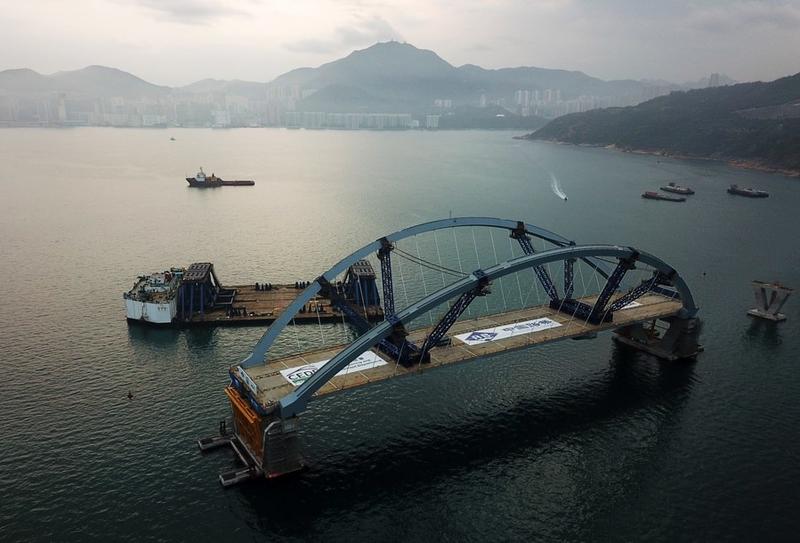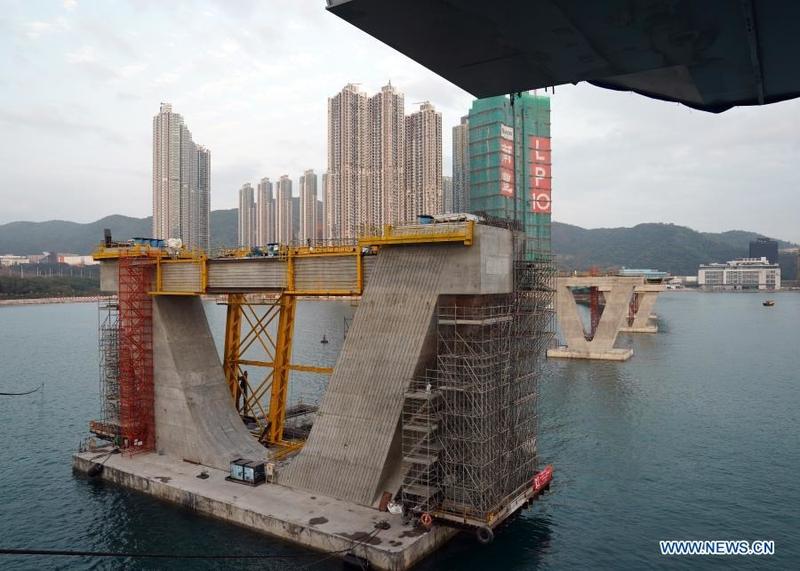 This aerial photo taken on Feb 26, 2021 shows an erected double-arch steel bridge of the Cross Bay Link, Tseung Kwan O, in Hong Kong. (LI GANG / XINHUA)
This aerial photo taken on Feb 26, 2021 shows an erected double-arch steel bridge of the Cross Bay Link, Tseung Kwan O, in Hong Kong. (LI GANG / XINHUA)
HONG KONG - "How will you hoist the steel bridge? A lot of people have asked me in the past weeks," said Kan Jun, director of China Road and Bridge Corp., contractor of a cross-bay bridge project in Hong Kong.
A prefabricated double-arch steel bridge for the Cross Bay Link, Tseung Kwan O, was erected by the project team on the bridge piers on Feb 26 in Hong Kong.
It's never been easy to hoist a prefabricated bridge which weighs over 10,000 tons, particularly, above sea, however, the Chinese experts came up with a better solution to install the bridge.
"We use the 'float-over method' to erect the bridge," Kan, who is also the project director, said.
With a length of 200 meters and a weight of about 10,000 tons, the double-arch bridge that's constructed using high-strength steel will be the longest span and heaviest steel arch bridge in Hong Kong upon completion and another landmark cross-sea structure
This is the first time that the method has been applied to build a bridge in China, he said proudly.
ALSO READ: Double-arch steel bridge for Cross Bay Link erected
'We maximize prefabrication'
"Does anyone know what this is?" asked a netizen who posted photos on a local online forum some three weeks ago, showing a double-arch structure above sea level. "Is that a bridge being shipped?"
In the eyes of some netizens, the double-arch steel bridge resembles a floating butterfly.
"It's the new bridge for the Cross Bay Link, Tseung Kwan O," another netizen gave the answer.
Spanning the Junk Bay in southeastern New Territories of Hong Kong, the Cross Bay Link is about 1.8 km long, of which 1 km is a marine viaduct and the steel bridge is an integral part of the viaduct.
With a length of 200 meters and a weight of about 10,000 tons, the double-arch bridge constructed using high-strength steel will be the longest span and heaviest steel arch bridge in Hong Kong upon completion and another landmark cross-sea structure.
"We maximized prefabrication in this project," Kan told Xinhua. "It's also an example of cooperation and connection between Hong Kong and the mainland."
The bridge components were fabricated at yards in the city of Nantong, east China's Jiangsu province, as well as in the Xinhui district of Jiangmen city and Panyu district of Guangzhou city, in southern Guangdong province.
Owing to its excellent strength-to-self-weight ratios, S690 steel was used for the bridge. "It is a breakthrough," Kan said.
Research projects were conducted involving experts from Hong Kong and the mainland to overcome technical problems, such as concerns regarding strength and ductility of the S690 welded sections.
After assembly, the arch bridge, as a complete structure, was put on a delivery vessel - a semi-submersible barge - and entered the Junk Bay on Feb 16 after traveling over 1,660 km on the sea for eight days from Nantong.
 This photo taken on Feb 25, 2021 shows the double-arch steel bridge of the Cross Bay Link, Tseung Kwan O, before its installation in Hong Kong. (LI GANG / XINHUA)
This photo taken on Feb 25, 2021 shows the double-arch steel bridge of the Cross Bay Link, Tseung Kwan O, before its installation in Hong Kong. (LI GANG / XINHUA)
Besides the precast steel arch bridge, the team used the precast shells to replace the cofferdam for in-situ pile caps construction, replaced the in-situ casting piers with precast V-piers, and also used precast box girders for this project.
The large-scale precast method increases efficiency and better controls quality and workmanship of the project, and it also minimizes marine construction in order to reduce safety risks, protect the environment, and minimize the impact of the project on the nearby residents, Kan explained.
Perfect timing
The project team made a rehearsal for the erection of the steel bridge on the afternoon of Feb 25.
Kan took out a folded piece of paper from his pocket. "It's the timetable," he said. The project team had conducted a meticulous analysis of every step of the procedure to ensure the smooth execution of the erection process.
According to the schedule, the steel bridge would be installed by ballasting of the barge with the help of tide.
Tidal conditions are vital to the installation, said Yao Zhenghua, production director of ZPMC Offshore Service Group, the project's subcontractor.
The project team chose Feb 26 for the installation because of the ideal tidal conditions forecasted.
"We will make the most of the slack tides which would last for about two hours tomorrow," Yao, also the on-site director of the installation, told Xinhua aboard the barge on Feb 25.
It was the first time in China that a bridge project adopted the method of large-scale prefabrication, whole bridge delivery and on-site installation, said Kan Jun, director of China Road and Bridge Corp., contractor of Cross Bay Link, Tseung Kwan O
At about 7 am local time on Feb 26, the barge loaded with the steel bridge moved in between the bridge piers during the high tide window.
After precise positioning of the steel bridge, the barge pumped in seawater for ballast, correspondingly lowering the barge for the steel bridge to touch down onto the piers. The entire process of erection lasted about five hours until close to noon.
"Well done!" Kan cheered along with about 70 on-site engineers and constructors.
It was the first time in China that a bridge project adopted the method of large-scale prefabrication, whole bridge delivery and on-site installation, he said.
READ MORE: Chinese solutions break new ground
Kan came to work in Hong Kong in 1992 when the technological capabilities of Chinese engineering companies lagged behind their foreign rivals, he said.
"Chinese companies were mistrusted," he said.
"When I first arrived in Hong Kong, a British engineer even thought that I didn't know how to vibrate concrete," Kan recalled. "I will never forget that experience."
"But now, dozens of industry professionals in Hong Kong have told me that they want to visit the fabrication yard in Nantong."
"China is making strides in bridge construction technology," he said. "I'm proud of it."
Over the past decades, Kan has taken part in numerous bridge and road construction projects in Hong Kong. "When my son was a preschooler, every time we passed by a construction I participated in, he would say 'Papa's bridge' or 'Papa's building'," he said.
 This photo taken on Feb 25, 2021 shows the Tseung Kwan O bridge under construction in Hong Kong. (LI GANG / XINHUA)
This photo taken on Feb 25, 2021 shows the Tseung Kwan O bridge under construction in Hong Kong. (LI GANG / XINHUA)
Eternity arch, vibrant town
Dubbed "Mammoth," the steel bridge has been welcomed by local residents since it entered Hong Kong.
Hong Kong residents fascinated by the bridge flocked to the Junk Bay, with some taking aerial photos and drone videos and posting the visual delights on social media.
Netizen Jason shared online his jogging by the bay after the erection of the bridge was completed to mark the "historic moment."
The "Eternity Arch" option was adopted to showcase the marine viaduct after collecting ideas and concepts from the public.
Two outwardly leaning arches and the gradually narrowing piers form an interconnected ring. To view from both shores, it appears as the mathematical symbol of infinity, which chimes well with the vibrant town of Tseung Kwan O.
READ MORE: New cross-sea link under construction in Greater Bay Area
Tseung Kwan O is one of the latest generations of new town developments in Hong Kong. With the further population intake in the area, traffic demand will grow accordingly.
The cross bay link will connect the southeastern areas of Tseung Kwan O with the Tseung Kwan O-Lam Tin Tunnel and link Tiu Keng Leng and Tseung Kwan O town center. The project is scheduled for completion in 2022.
As well as providing transport connection, the phenomenal piece of infrastructure features a dual two-lane carriageway with a cycle track and footpath.
Netizens in Tseung Kwan O are excited about the construction of the cross-bay bridge which will enable them to embrace a new lifestyle. They also expect the bridge to be a landmark for cyclists.


